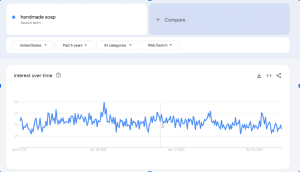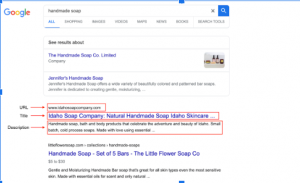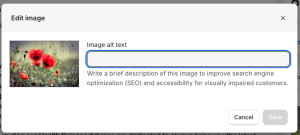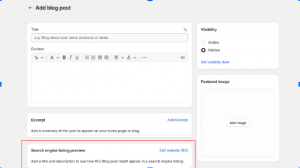Shopify SEO Optimization Guide for Beginners in 2024 (Step-By-Step)
As you navigate the competitive world of e-commerce, the increasing costs of paid advertisements might make you ponder alternative strategies to attract visitors to your online store. Today, we share an effective and cost-efficient way to increase traffic that doesn’t hinge on continuous financial input: search engine optimization, commonly known as SEO. Leveraging the power of SEO can help your business appear more prominently in search results, thus driving organic traffic to your Shopify store.
Understanding and implementing SEO is crucial. Our goal is to empower you with methods that have been refined through years of experience. By demystifying SEO, starting with selecting the right keywords for your store using tools like Google Keyword Planner and embedding those keywords strategically across your site, you can enhance your store’s visibility and rake in sustainable traffic. Let’s explore how to integrate SEO tactics into your Shopify store and see tangible results.
Key Takeaways
- Utilize SEO strategies to generate ongoing, cost-free traffic to your Shopify store.
- Leverage tools like Google Keyword Planner for keyword research to optimize your store’s search ranking.
- Embed primary and secondary keywords in your store’s content to boost visibility in search engine results.
Optimizing Your Shopify Store for Search Engines
Goals of SEO for Your Shopify Store
Enhancing your Shopify site’s visibility in search results is a key strategy to attract more traffic without the ongoing cost of advertising. By optimizing your online store, you’re aiming to secure a high position on search engine results pages (SERPs) for specific keywords related to your products. This will increase the likelihood that potential customers will find your store when they search for items you sell. Doing local keyword research can further boost your visibility by targeting search terms specific to your geographic area, attracting nearby customers ready to make a purchase.
- Identify primary and secondary keywords with substantial search volumes.
- Incorporate these keywords strategically in your store’s content.
How Search Engines Determine Your Store’s Placement
Search engines use complex algorithms to decide which websites to display for a search query. They scan your site for certain markers that indicate the relevance and quality of your content. It’s vital to ensure these markers—like title tags, headings (H1 tags), and on-page text—reflect your target keywords.
- Use title tags and H1 tags infused with your chosen keywords.
- Write engaging, keyword-rich descriptions for your product and collection pages.
- Implement alt tags for images, reinforcing the connection to your keywords.
| Action Item | Purpose |
|---|---|
| Title Tags with Keywords | Tells search engines the primary topic of the page |
| H1 and On-Page Text with Keywords | Emphasizes the content’s focus, bolstering relevance |
| Meta Descriptions with Keywords | Provides a concise summary for search engine snippets |
| Image Alt Tags with Keywords | Aids search engines in understanding image content |
Remember, tools like Google Keyword Planner can guide you in selecting the most potent keywords for your store. By focusing on effective SEO techniques, as explained here, you set up your online store to garner more free, organic traffic over time.
Conducting Effective Keyword Investigations
Using the Google Keyword Tool
Google offers a free resource, the Google Keyword Tool, which is essential for pinpointing precisely the search terms potential customers use when seeking products you offer. By entering your anticipated customer search terms into the tool, you can gain insights into a variety of keywords linked to your product, and it will reveal the average monthly searches for each. Integrating tools like this as part of a Devtools Marketing strategy helps store owners take a data-driven approach, refining keyword selection and aligning it with broader marketing goals This assists in formulating your keyword strategy.
- First Step: Input assumed search terms related to your store items.
- Key Metrics: Monthly search volumes for desired keywords.
- Outcome: Selection of optimal keywords to enhance store visibility.
Analyzing Search Trends

It’s crucial to filter keywords based on their average monthly search statistics. Identifying terms with sizable search figures is beneficial, as high-frequency searches correlate with better visibility and traffic prospects. Opt for those keywords that balance high search volume and relevance to your store’s offerings.
- Analyze monthly search volumes:
- Primary Search Term: e.g., “handmade soap.”
- Monthly Searches: Number of times the term is searched per month.
- Relevant secondary terms with substantial search counts are worthy of consideration.
Selecting Primary and Secondary Keywords
Deciding on a primary keyword alongside a secondary ones is a strategic endeavor. Your predominant keyword should have the highest relevance and search volume and serve as the focal point of your SEO efforts. The auxiliary keywords should support the primary one and have considerable search volumes.
- Primary Keyword: The most significant keyword intended for ranking.
- Secondary Keywords: Supportive terms to augment the primary keyword.
- Application: Ensure these keywords are integrated into Shopify’s designated areas for maximum effect.
Primary and Secondary Keywords Table:
| Keyword Type | Example Keywords | Monthly Searches |
|---|---|---|
| Primary | Handmade Soap | The number provided by the tool |
| Secondary | Natural Soaps | The number provided by the tool |
| Secondary | Homemade Soaps | The number provided by the tool |
Optimizing Your Shopify Store for Search Rankings
Creating Impactful Page Titles and Headings
When setting up your Shopify store, it’s crucial to input your primary and related keywords into your page titles and H1 tags. These flags you wave to search engines, signaling what your page is about. Remember:
- Page Titles: Wrap your primary keyword in a compelling page title.
- H1 Tags: Make sure your primary keyword is also prominent in the main header of your page.
These tweaks will help search engines understand and categorize your content effectively.
Crafting SEO-Friendly Product Descriptions
Your product descriptions aren’t just for potential customers; search engines eat them up, too. Here’s how you’ll make your products more discoverable:
- Keywords: Scatter your primary and secondary keywords naturally throughout your descriptions.
- Metadata: Craft concise meta descriptions using these keywords. They’re the sneak peek users get in search results.

Setting Up SEO for Your Collections
Your collection pages are prime real estate for SEO. Keep these practices in mind:
- Collection Description: Inject your main keywords into a rich narrative describing what your collection is about.
- SEO Settings: The page title, meta description, and URL handle should contain your primary keyword.
- Execution: Click “Save” after making these changes to lock them in.
Optimizing Product Pages for Search Engines
Product pages follow a similar blueprint to collections but with an additional feature:
- Alt Tags for Images: Always describe your product images using alt tags, which should be peppered with your keywords. This helps search engines grasp the content of your images

Implementing these SEO strategies diligently can increase your visibility in search results and bring free, organic traffic to your Shopify store.
Optimizing Shopify Store’s Loading Speed.
Don’t forget to optimize your store’s speed, as you don’t want to have your hard-earned users from SEO and not only to bounce.
Implementing these steps can lead to significant improvements in your Shopify store’s loading speed, enhancing user experience and potentially boosting conversion rates. Alternatively, you can use Shopify speed optimization app like SearchPie, that can improve the speed on autopilot.
- Image Optimization: Compress and resize images to reduce file sizes. Use tools like TinyPNG or Shopify apps to optimize images without losing quality.
- Minimize HTTP Requests: Combine CSS and JavaScript files, reduce the number of images, and utilize CSS sprites to decrease the number of HTTP requests.
- Use a Content Delivery Network (CDN): Utilize Shopify’s built-in CDN or third-party CDNs like Cloudflare to cache static content and serve it from servers closer to your visitors, reducing loading times globally.
Harnessing SEO Strategies
SEO Action Plan
First of all, it’s crucial to understand that attracting shoppers to your online business without continually spending money on ads is possible through SEO—optimizing your site for search engines to drive organic traffic. I’ll run you through critical tactics to achieve better visibility on search engine results pages.
Identify Relevant Keywords:
- Primary Keyword: Pinpoint one keyword with a substantial search volume that aligns with your product’s core offering. For example, if you’re selling artisan soaps, “handmade soap” might be your prime pick.
- Supporting Keywords: Choose two additional keywords related to the main one. Considering the above instance, “natural soaps” and “homemade soaps” can complement your primary choice.
SEO Checklist Table
| SEO Elements | Tips to Optimize |
|---|---|
| Title Tags | Include primary and secondary keywords. |
| H1 Tags (Headings) | Place your main keyword prominently. |
| Page Content | Weave in keywords naturally. |
| Meta Description | Insert keywords and make it compelling. |
| URL Handle | Reflect the primary keyword in the URL slug. |
| Image ALT Text | Describe images using keywords for SEO boost. |
Link Building Strategy
A crucial aspect of any successful SEO strategy, particularly for e-commerce sites like Shopify stores, is link building. This involves creating a network of links from other websites back to your own, which not only drives direct traffic but also boosts your site’s authority and ranking on search engines. Start by identifying relevant websites, such as blogs and industry publications, and engage with them to create content that includes backlinks to your Shopify store. Additionally, leveraging social media platforms to share your content and encourage others to link back to it can amplify your efforts. Regularly analyzing your link profile to weed out any harmful links and tracking your progress through tools like Google Search Console can ensure that your link-building efforts are effective.
Introduction to Conversational Models for SEO
A cutting-edge tool that’s reshaping the SEO content landscape is Chat GPT. This AI-powered platform helps create content that resonates with search engines and readers.
Implementing Chat GPT:
- Writing Compelling Descriptions: Use Chat GPT to craft unique descriptions containing your chosen keywords. Integrate those into
- Collection descriptions
- Product narratives
- Meta descriptions for better visibility.
- ALT Tags for Images: Enhance your images with descriptive ALT tags that convey the essence of the picture and contain relevant keywords.
Remember, consistently applying these tips across all aspects of your online shop will greatly enhance your SEO performance.
Helpful Hints for Improving Your Online Store’s Visibility
Creating Content for Better Search Visibility
When looking to draw visitors to your Shopify store without the hefty price tag of ads, focus on creating attractive content to search engines. Here’s how to beef up your store’s content strategy:
- Use the Google Keyword Planner to identify high-search-volume phrases that align with what you’re selling. These are the words your potential customers are entering into search engines and the ones you’ll want to rank for.
- Choose a main keyword and a couple of related keywords. For instance, if you’re selling artisanal soaps, you might select “handmade soap” as your main keyword and “natural soaps” and “homemade soaps” as secondary ones.
- Incorporate these keywords thoughtfully into your store’s text – your title tags, H1 tags (main headings), product descriptions, and even in your URL slugs.
- Write engaging, keyword-rich descriptions for your collection and product pages, ensuring you naturally include primary and secondary keywords without sacrificing the readability of your content.
Mastering the Use of Image Descriptions
Alt tags are crucial in communicating the content of images to search engines, which can’t visually interpret them. Here’s how to optimize your images:
- Alt tags should be accurate and descriptive. If you’re selling organic cleansers and have an image of a bar of natural soap, describe it in your alt tag.
- Always include relevant keywords in your alt tags. Align them with the keywords you are targeting for better search engine rankings.
- Don’t skip alt tags for any images. Each tag is an opportunity to improve your product’s visibility in image searches, which can be just as important as text searches.
By implementing these techniques, you set your Shopify store up for greater visibility, potentially attracting more visitors organically.
Perfecting Your Online Store’s Organic Reach
Implementing Adjustments in Your Shopify Dashboard
When you’re all set with choosing the right keywords for your e-commerce site, the next step is to embed these terms strategically across your Shopify store. Think of this as leaving breadcrumbs for search engines so they can easily understand your page and show it to potential customers.
Collections Pages
- Title Tags: Make sure your main keyword is in the collection’s title to grab search engines’ attention.
- H1 Tags: This is your heading tag and must include your primary keyword.
- Page Descriptions: Include both primary and secondary keywords concisely.
- URL Handle: Slip your primary keyword into this space for better indexing.

Example:
| Component | Placement Recommendation | Note |
|---|---|---|
| Primary Keyword | Title Tag, H1, Description, URL | Essential for search engines to categorize the page |
| Secondary Keywords | H1, Description | Supports the primary keyword for better relevance |
Product Pages
- Title and Description: Inject the primary and secondary keywords just as with collection pages.
- Alt Tags on Images: Describe what the image is about, using keywords ideally; this way, search engines can recognize the image content.
Tip*: For more in-depth guidance on optimizing your e-commerce product pages, you can check Ignite Visibility’s service crafted specially for this case.
Saving Changes on Shopify
Once these changes are integrated, don’t forget to hit the ‘Save’ button to confirm the update. It’s a small but essential step to ensure all the hard work you’ve put into SEO pays off.
In conclusion, whether you prefer to take charge of your Shopify SEO journey with our detailed guide or seek guidance from top experts, the power to enhance your store’s visibility and drive organic traffic lies in your hands.
